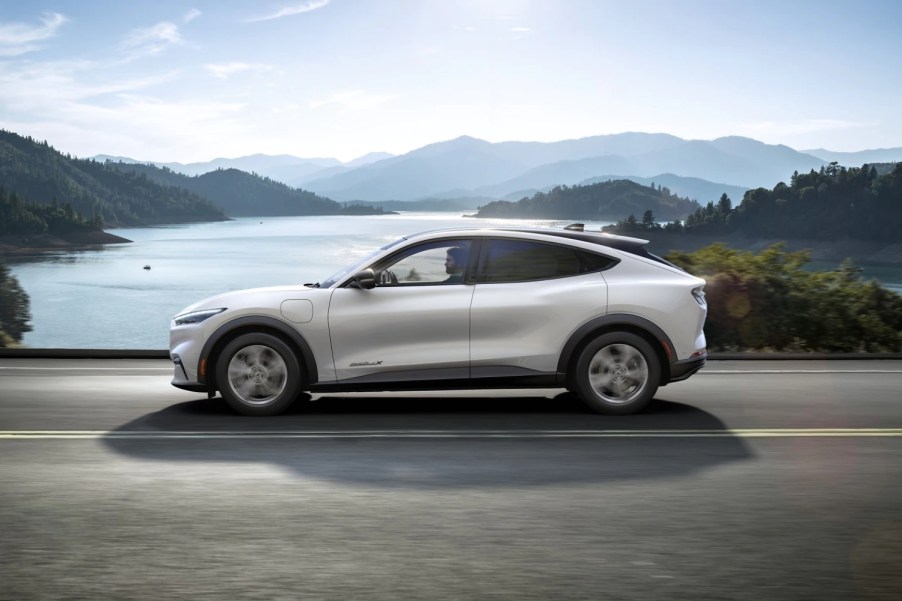
How Did Ford Lose $3.1 Billion in Q1 With the Successful Mustang Mach-E?
Ford is everywhere right now, thanks to an ever-evolving lineup of new cars. With the successful Ford Mustang Mach-E electric SUV and F-150 Lightning truck, how did the brand lose $3.1 billion in the first quarter of the year? Supply chain issues, semiconductor chip shortages, and just plain old supply and demand, mostly.
The Ford Mustang Mach-E and F-150 Lightning have been successes

No matter where you look right now, Ford trucks, SUVs, and cars are everywhere. With the Ford Mustang Mach-E winning awards left and right (Including the MotorBiscuit EV of the Year award) and the successful launch of the Lightning truck, Ford is on fire. However, Ford posted its Q1 2022 numbers and confirmed a net loss of $3.1 billion. How did that happen?
Ford attributes this loss “to a mark-to-market loss of $5.4 billion on the company’s investment in Rivian.” Ford’s stake in Rivian dropped from$10.6 Billion at the end of 2021 to $5.1 billion at the end of Q1. In addition, Ford says that more expensive products, a decline in vehicle shipments, and lower sales in trucks and SUVs are also attributed to the loss.
“The appeal of these products – Bronco, Bronco Sport, Maverick, Mustang Mach-E, E-Transit
Jim Farley | Ford CEO
and now the F-150 Lightning – is undeniable.”
Farley went on to say that the popularity of the lineup has translated into orders, which is the goal. Ford wants to deliver “great experiences” to the customers to keep up with its popularity. Farley went on to say it was trying to ramp up production and manufacturing as a result. Turning orders into actual Mustang Mach-E deliveries quickly is the goal.
Ford Mustang Mach-E and F-150 Lightning production has been slow
For the first quarter of 2022, Ford reported $34.5 billion in revenue, down nine percent over 2021. For the most part, the automaker blames semiconductor chip shortages and COVID-19 supply chain issues for the loss. Due to this, Ford could not keep up with customer demand even though interest was strong.
Either way, Ford delivered almost 970,000 vehicles in the first quarter. It anticipates the semiconductor chip shortages to even out in the next few months, hoping for “full-year vehicle wholesale volumes increasing 10% to 15% from 2021.” Plus, the launch of the new Ford+ plan should add growth.
It says that the conflict in Ukraine has complicated supply chain issues but in a limited manner. However, if it continues, “the situation in Eastern Europe could exacerbate broader supply issues over time.”
The EV market is getting more crowded every day
According to Kelley Blue Book, the Ford Mustang Mach-E came in third place for electric vehicle sales in Q1. In first and second place, the Tesla Model Y electric SUV and Model 3 sedan made up 68% of sales. 46,707 Model 3’s moved off dealership lots while Ford sold 6,734 Mach-E EVs. That’s a huge difference between second and third places.
However, with 32 different electric vehicle models on the market, Tesla’s hold is growing weaker. Ford hopes to be able to produce and deliver more Mach-E’s than ever before in Q2 2022. As it stands right now, the 2022 Ford Mustang Mach-E is sold out. Ford says, “Due to high demand, the current model year is no longer available for retail order. Limited inventory may be available at selected dealers.”
Ford has big plans for Q2 and seems to be doing everything in its power to keep making electric SUVs and trucks as fast as it can. If you wanted to get in on the Ford Mustang Mach-E action, be sure to place a reservation when ordering for the 2023 Mach-E opens up.



